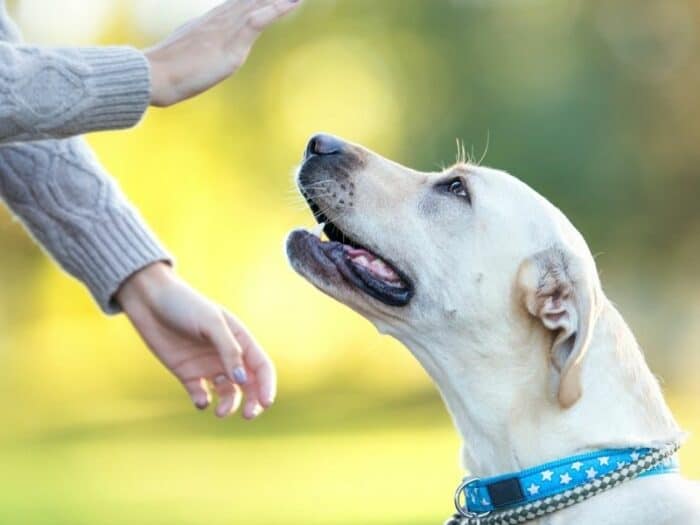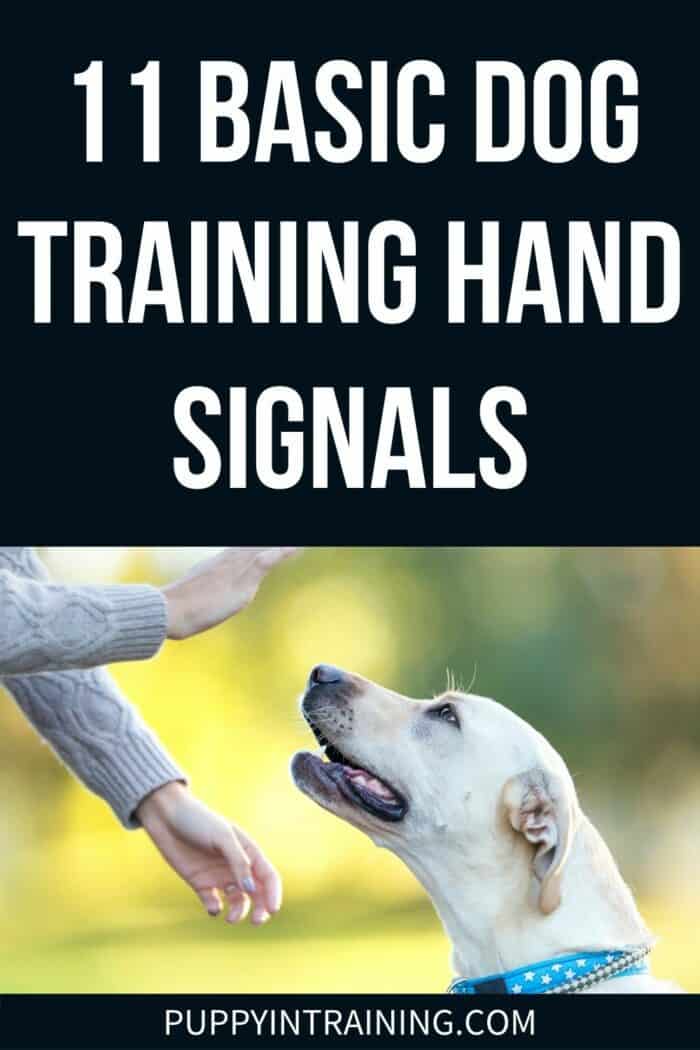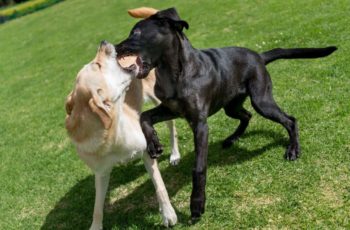This post may contain affiliate links. We may earn money or products from the companies mentioned in this post.
You may wonder why you should teach dog training hand signals at all. It’s a valid question which I also asked many years ago.
When Linus was a puppy we taught him hand signals along with verbal commands.
At that time our trainer gave us two big reasons for using hand signals with our dogs.
Number 1: Your dogs can respond better from distance.
Number 2: If your dog goes deaf he can still respond to your hand signals (and vice versa for verbal commands if your dog goes blind).
More reasons on why you should teach your dog hand signals below.

There are many reasons for teaching hand signals to your dog in addition to voice commands. And doing so can significantly improve your dog’s life.
Dogs don’t really understand the words we use. But they do understand sounds, which is how they learn verbal cues.
Reasons To Teach Hand Signals to Your Dog
Here are some of the reasons why you should teach your dog hand signals:
- Teaching hand signals to your dog can increase his overall focus on you. He’ll learn to watch for your cues.
- It’s also beneficial in noisy environments in which he may not be able to hear a verbal cue.
- And sometimes dogs become deaf. So hand signals are necessary to communicate with them. One of my shelties, Amber, became deaf when she was about 13 years old. It really helped that she knew hand signals. I could even trust her when she was off-leash because she responded to my hand signal to come. And when I called her in from pottying at night I didn’t wake the neighbors. She came to me after I cued her with a hand signal to come.
- Having your dog focus on hand signals can also sharpen his mind. The more dogs learn, the better. And they won’t be bored.
- All positive training also improves the bond between you and your dog.
- Also, if you intend to compete in advanced obedience competitions, your dog will need to learn hand signals.
- I do compete with some of my dogs. But I teach all of them hand signals.
- It’s natural for dogs to read our body language. And if we’re consistent in our visual cues, they’ll learn them. An Italian Study found that dogs responded to hand signals with 99 percent accuracy, whereas they responded to verbal commands with only 82 percent accuracy. Even when conflicting verbal and visual signals were given, dogs properly responded to the visual cue 70 percent of the time. The study was conducted on 10 goldens and 15 Labs–highly trainable dogs.
So it’s really worth the time and effort to teach visual cues to our dogs.
Tips For Teaching Dog Training Hand Signals
It’s best if dogs know both verbal cues and hand signals. You never know when either will come in handy.
PRO-TRAINER TIP: When training, always mark the behavior you desire with a “yes!” or a click, followed immediately by a treat. Have your reward treat ready. For a reward, you want to have small, pea-sized treats that your dog values ready.
Of course, when you’re first teaching the hand signals, teach verbal cues separately so that your dog doesn’t become confused.
If your dog already knows the verbal cue for the command, then you can pair that with the visual cue when teaching your dog the hand signal.
Assuming your dog knows the verbal cue, use that and the hand signal the first few repetitions. Praise and treat after each repetition that your dog’s correct. Then do a few repetition with just the hand signal to see if he really understands the signal.
If he’s confused, do both the verbal and visual cue together again for a session or two before transitioning to just the hand signal.
Then, after your dog knows both, you can do either separately or together. If your dog already knows a voice command well, you can pair it with the hand signal.
11 Common Hand Signals
The first obedience command all dogs should learn is to pay attention. It’s the foundation of everything else that we teach our dogs.
As long as you’re consistent with your hand signal, any one that the dog can easily see will work.
There are some standard ones that have been developed. And they work well because the cue they give helps show the dog what to do.
Always start your training without distractions. So start inside without any noise or visual distractions. Once your dog learns what the hand signal means, you can add some distractions.
Train in short sessions of five to 15 minutes, depending on your dog’s focus. And do only a few repetitions of each exercise.
Always end on a positive note. You don’t want to do more than a few of the hand signals in any training session.
So that your pup will be able to focus on what you’re training, make sure that he’s been exercised so that the edge is off. You want him to be calm but not tired.
And always use the same hand for the same hand signal. You can use different hands for different signals. Just be consistent.
1. Attention Command
When I teach a dog the verbal cue, I use the word “look.” Many people use “watch me.” In training, consistency is what’s important.
For a hand signal, you can point with one finger to your eyes. Usually people use the index finger.
Have your hand and finger point from the side of your face, not in front, so that your dog can see what you’re doing even from a distance.
Always use the same hand for this cue to be consistent.
Right after your dog looks at you, mark the behavior and give the treat, so that he knows he did what you wanted.
To start to teach it, you can even have the reward treat in the hand you point with, giving your pup the treat after you praise him.
2. Sit
This is usually one of the first commands we teach our dogs. It’s very useful and teaches impulse control.
Have your hand, palm up, in front of your dog’s nose. Start with a treat in your hand. Slowly move your hand upwards toward your dog’s forehead.
This signal works well because we’re luring the dog into the sit.
3. Down
To teach your dog a signal, you can hold your index finger out in front of your chest horizontally.
To start, have a treat in your closed fist. You can flick your hand in a downward motion, with your finger pointing to the floor to help show your dog what you want.
You can even move your elbow and swing your pointed finger towards the floor as your signal. This helps lure the dog down.
4. Stay
The stay command can save your dog’s life.
He won’t rush out the front door or into the street if he listens. It can literally be a life-saver.
Raise your hand and hold your palm out facing away from you. Then hold the signal about or slightly above waist-high.
For a smaller dog, hold it in the lower position and just above the waist for a taller dog.
5. Come
This is one of the most important commands you can teach your dog. It’s another command that can save his life and prevent him from getting lost.
I teach it with a motion that the dog can see at a distance–if necessary.
With your dog a few feet away, make a horizontal huge sweeping wave next to your body (palm out), with your arm swinging in an exaggerated large horizontal wave motion.
Your palm should then come to rest gently on your chest.
6. Heel
Heeling means a dog walking with his shoulder area next to your left leg. It’s required if you show your dog in competitions.
But you can teach your dog to walk on your right side instead if you choose. Just be consistent
You can either tap your hip or make a circular motion in that area to help call your dog there.
You can start with a treat in your hand to lure him into position. Then mark the behavior and give the treat when he goes into position next to you.
7. Drop It
This is another command that can save your dog’s life.
Suppose that he picks something up that he shouldn’t have. You need to get it away from him ASAP.
If you chase him, he just makes it a game. And, with four legs to our two, he’ll probably win.
So teach him to drop it. The command also comes in handy when playing fetch with your dog.
To train it, if your dog is holding a toy in his mouth, show him your closed fist right in front of him.
Then open your fist. When he drops his toy, praise and reward him.
To help him learn the command, at first, you can have a treat in your closed fist to exchange for the toy.
8. Place Command
It’s really useful for your dog to go to a place such as a bed or crate.
To show him what you want, point a finger at the location. At first, you’ll have to be right next to the object.
Once he understands what’s expected, you can move a little farther away when giving the signal.
Praise and reward when he goes to the place.
9. Good Job!
You always want to let your dog know when he’s done a great job.
At first, we do this with treats and verbal praise. But eventually you’ll phase down the amount of treats your dog gets after he performs a behavior reliably on cue.
You’ll give treats on a very random schedule.
But what if you can’t give verbal praise because of the situation (too noisy) or your dog has hearing loss?
You can teach him a visual signal that tells him that he’s been a very good boy.
Use a thumbs-up signal, then praise and treat immediately, to teach him what it means.
This is a universal signal to humans and canines now.
10. Quiet
Sometimes we need our dogs to be quiet.
Some of the breeds I have are notoriously vocal: shelties, a Lhasa apso, and an Aussie mix.
So that we’d have some peace and quiet in our house–and outside for others–I needed to teach my dogs a quiet cue.
They learned what the word “quiet” meant, because I praised and rewarded the split second they stopped barking.
The hand signal I taught was putting my index finger perpendicular to my lips.
11. Recess: You’re Free!
When you’re done with your training session, you should let your canine buddy know when it’s over.
He’ll have recess and be free from working. He can go off to play or chew his bully stick.
You can hold both arms up, palms facing forward, and flutter your hands a few times. The session then ends.
Final Thoughts
Training your dog to learn hand signals can be very practical. It can also be beneficial because he won’t be bored and your bond will be even closer.
It’s easier than it looks because dogs naturally read our body language. Sometimes, they’ll perform better with visual cues than they will with verbal ones!
So take your training to another level and teach hand signals.
Have you taught your dog to respond to hand signals? Tell us about it in the comments section below.
Save To Pinterest

Top Picks For Our Puppies
- BEST PUPPY TOY
We Like: Snuggle Puppy w/ Heart Beat & Heat Pack – Perfect for new puppies. We get all of our Service Dog pups a Snuggle Puppy. - BEST DOG CHEW
We Like: Best Bully Sticks – All of our puppies love to bite, nip, and chew. We love using Bully Sticks to help divert these unwanted behaviors. - BEST DOG TREATS
We Like: Wellness Soft Puppy Bites – One of our favorite treats for training our service dog puppies. - BEST FRESH DOG FOOD
We Like: The Farmer’s Dog – A couple months ago we started feeding Raven fresh dog food and she loves it! Get 50% off your first order of The Farmer’s Dog.
Check out more of our favorites on our New Puppy Checklist.


